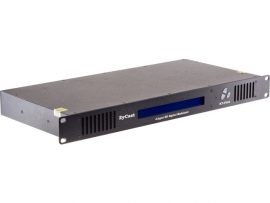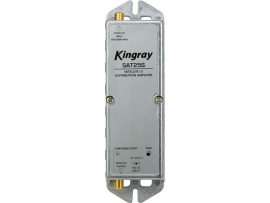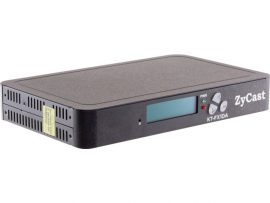Description
Clearview HD4112SE Quad HDMI HD MPEG2 Modulator
ClearView Low Cost HD4112se Quad HD MPEG2 DVBT HDMI Modulator 4RF Carriers Out- Web GUI and LCD Control.
Details
The Clearview HD4112SE HDMI Modulator Encoder Modulator supports 4 HDMI inputs, and 1 F (4 RF) female output.
After encoding and modulation, the input signal appears on 4 x RF carriers at the RF output.
The Clearview HD4112SE HDMI Modulator now has LCD Display and WEB GUI.
Features
▪ 4 HDMI inputs
▪ 4 RF carriers out
▪ HDCP compliant
▪ LCD and WEB GUI Control
▪ Rack Mountable
▪ 1080p resolution
▪ ONID, NID, LCN and TSID Adjustable
▪ Service ID and PIDs Adjustable
▪ Encoding Bitrate Adjustable
▪ Modulation Parameters Adjustable
▪ Firmware upgradeable via Ethernet Port
▪ Rack position for multiple unit installation.
▪ 2 cooling Fans Built in
▪ MPEG2 -Works on MPEG2 and MPEG4 TVs, IQ2, 3 and 4 tested.
Specifications
TECHNICAL SPECIFICATIONS
Encoding Section-Video
Encoding: MPEG2
Interface: HDMI x 4
Resolution
Input: PAL,NTSC 720@50p,720@60p 1080@50i/p,1080@60i/p
Output Max:1080@30p
Bit rate: 2-20Mbps
Encoding Section-Audio
Encoding: MPEG-1 Layer2, AAC
Sample rate: 48KHz
System
Management: Ethernet
Language: English
Upgrade and control: via Ethernet
Menu Configuration
General Frequency/ RF Attenuation/ Service Name/ Modulation/LCN
Stream/Encoder
PMT PID/Video PID/Audio PID/PCR PID/TS ID/ Service ID/
ON ID/ Network ID/Service provider/Network Neme/Min
Bitrate/Max Bitrate/Audio Encoder/FHD Output
Network: IP Address/Subnet Mask/Default Gateway/MAC Address
Update: Controller Firmware/Modulator Firmware/Main MCU
Modulator Section
MER >35dB
RF range: 100 to 950MHz in1KHz steps
RF output level: 100dBμV(25dB Attenuation)
Standard: DVB-T
Bandwidth: 6M, 7M, 8M
Constellation: QPSK, 16QAM, 64QAM
Code rate: 1/2, 2/3, 3/4, 5/6, 7/8
Guard interval: 1/4, 1/8, 1/16, 1/32
FFT: 2K, 8K
General
Power supply: 100-240V AC 50/60Hz
Dimensions: 484 x 135 x44mm
Weight: 1200g
What’s the difference between MPEG2 and MPEG4?
DVB-T (Digital Video Broadcasting – Terrestrial) is a standard for transmitting digital television signals over terrestrial (over-the-air) broadcast networks. MPEG-2 and MPEG-4 are video compression standards used in DVB-T to encode the video content.
- DVB-T MPEG-2: DVB-T MPEG-2 refers to the use of the MPEG-2 video compression standard within the DVB-T system. MPEG-2 is an older compression standard that was widely used for digital television broadcasting before the introduction of MPEG-4. It offers moderate compression efficiency, which means it requires more bandwidth to transmit video compared to MPEG-4 for the same quality. MPEG-2 provides good video quality, especially for standard definition (SD) content, and it is still compatible with many older television sets and receivers.
- DVB-T MPEG-4: DVB-T MPEG-4, on the other hand, uses the more advanced MPEG-4 video compression standard. MPEG-4 offers better compression efficiency, allowing broadcasters to transmit higher quality video using less bandwidth compared to MPEG-2. This is especially beneficial for high-definition (HD) and other bandwidth-intensive content. MPEG-4 can deliver superior video quality with the same amount of data or equivalent video quality with less data compared to MPEG-2. However, MPEG-4 requires more processing power for encoding and decoding, which means older television sets or receivers may not support MPEG-4 without a compatible decoder.
In summary, the main difference between DVB-T MPEG-2 and DVB-T MPEG-4 lies in the video compression standard used. MPEG-2 is an older standard with moderate compression efficiency but good compatibility with older devices, while MPEG-4 is a more advanced standard offering better compression efficiency for higher quality video but requiring more processing power and compatibility considerations.
How can I tell if my TV is MPEG2 or MPEG4?
Early digital TVs sold in Australia had MPEG2 DVB-T Tuners. Later models have progressed to MPEG4. Any MPEG4 TV will work with MPEG2 signals. However MPEG2 TVs will not work with MPEG4 signals including those from MPEG4 modulators.
It is often difficult to see from the TV’s specifications if the hardware is MPEG2 or MPEG4. The easiest way is to test the TV with a normal broadcast antenna signal. New HD Channels such as Channel 70 (7HD) or Channel 31 (SBS Viceland HD) are broadcast in MPEG4. If your TV produces a black picture or an error message such as FORMAT NOT SUPPORTED, then this TV is MPEG2 only.
To correct a MPEG2 only TV, a new DVBT Set Top Box can be used to tune the RF signal and convert it to a HDMI input on the TV.








